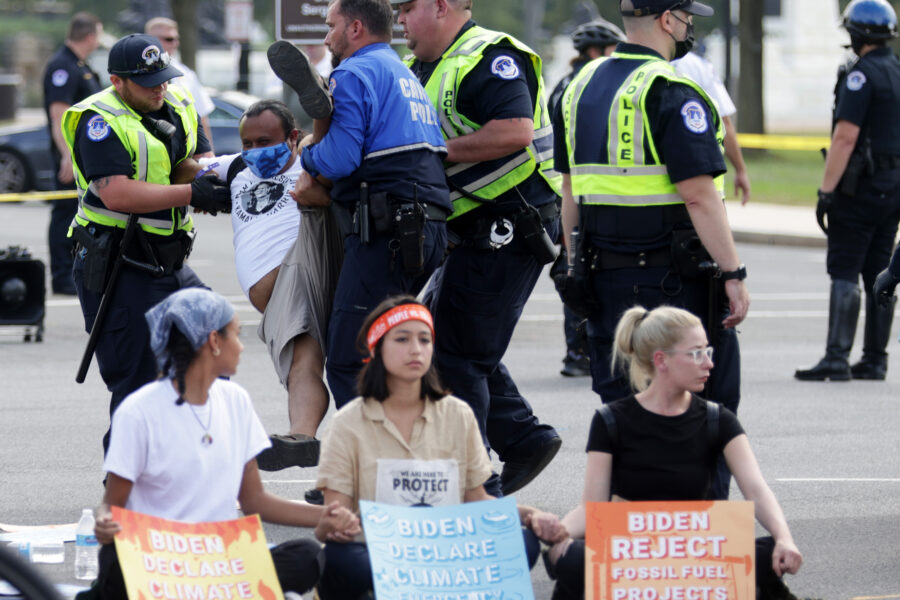To Incinerate Or Not To Incinerate: Maryland Hospitals Grapple With Question With Big Public Health Implications
Maryland’s two largest health systems have taken contrasting positions on their future dealings with a controversial medical waste incinerator in South Baltimore: Johns Hopkins Health System and University said it ended its dealings with the incinerator while MedStar Health gave no such assurance.
“We have ended all dealings with Curtis Bay Energy and are working to shift nearly all of
our medical waste disposal to more environmentally-friendly technologies, including autoclave and ozone sterilization facilities,” a Johns Hopkins University spokesperson said in emailed comments to Inside Climate News.
The representative noted that the Johns Hopkins system, which includes hospitals and the university, only used Curtis Bay Energy for about a quarter of its medical waste and the institution is working quickly to identify a new facility for the small portion of medical waste that requires incineration. “There are no currently available alternatives to incineration for several types of medical waste streams. We are actively seeking technological and location options for these waste streams,” the spokesperson said.
We’re hiring!
Please take a look at the new openings in our newsroom.
See jobsWhen approached for a comment about this story, MedStar Health’s regional director of media & public relations Debra Schindler replied in an emailed statement, “we will respectfully decline the opportunity at this time.”
MedStar operates four hospitals in greater Baltimore and its representative told the Baltimore City Council in March that they will continue the relationship with the incinerator.
Both Johns Hopkins and MedStar Health were forced to make public statements about their dealings with the incinerator after its operator, Curtis Bay Energy, pleaded guilty to 40 criminal counts for failing to properly dispose of dangerous medical waste in October 2023. The charges followed a lengthy investigation by Maryland’s attorney general’s office. The company subsequently agreed to pay an historic $1.75 million in fines for environmental infractions.
Less than five months later, the company was again in hot water. On March 14, the Maryland Department of the Environment (MDE) filed a suit against the company. The charges included exceeding emissions limits for multiple toxic pollutants and failing to comply with its air quality operating permit. The MDE asked the court to order the company to make necessary repairs to prevent future violations and impose fines.
The Curtis Bay medical waste incinerator is one of the largest medical waste incinerators in the U.S. and accounts for one-third of the nation’s medical waste burning capacity. Only about 6 percent of the waste incinerated at the facility originates in Baltimore, according to an estimate, while the rest comes from other states, with Pennsylvania being the highest contributor.
With a troubled history of environmental infractions and unpermitted emissions of hazardous pollutants, the Curtis Bay incinerator is the second highest pollutant-emitting facility in Curtis Bay, outdone by the Wheelabrator trash incinerator off I-95—the single largest stationary source of air pollution in Baltimore City. The nearby community is overburdened by harmful pollutants emitted by a range of industrial facilities in the surrounding areas including a massive open-air coal pier, a fuel tank farm, brownfields and a massive landfill.
Consequently, the neighborhoods near the incinerator are asthma hotspots and have disproportionally high hospitalization rates, according to Progressive Maryland, a nonprofit group campaigning against trash incineration. Residents are likely to die 3.9 years earlier than the city average, according to a city health department estimate, because of the cumulative impact of the environmental harm.
In March, the Baltimore City Council convened a public hearing following the state’s latest lawsuit against Curtis Bay Energy. The council invited health institutions operating in the city, including John Hopkins, the University of Maryland Medical Center and MedStar Health, to discuss their immediate future plans to mitigate the negative effects of their medical waste disposal on Baltimore communities.
“[W]e were upset and disappointed to learn about the actions of the Curtis Bay Energy staff that led to the original guilty plea in October and equally alarmed by the most recent lawsuit. This is certainly not what we expect from companies we do business with,” Bob McLean, vice president of facilities at Johns Hopkins University stated before the Baltimore City Council hearing on March 20.
McLean committed to diverting most of Johns Hopkins’ medical waste away from the Curtis Bay incinerator within the next 30 to 60 days. The self-imposed deadline ended on May 19 and a university spokesperson told Inside Climate News last week that the institution has ended its dealings with the incinerator.

Contrary to Hopkins’ position, Rachel DeMunda, MedStar’s director of environmental health, safety and sustainability, told the city council that incineration was necessary to eliminate harmful waste and that the health system intends to continue with incineration at the facility. She claimed that MedStar made the decision “after careful consideration.”
The statement irked Curtis Bay residents attending the hearing.
“It’s a step in the right direction for Hopkins to act on the information we as a community have brought to light about the ongoing violations at the medical waste incinerator. On the other hand, MedStar, including Harbor Hospital, which is right next to me here in south Baltimore … they aren’t even acknowledging there is a problem,” said Tiffany Thompson, a Curtis Bay resident who called for the city council hearing. “I wondered how MedStar Health can claim to be invested in the health of our communities when they won’t even talk to us about this major environmental health issue that impacts all of us.”
The MedStar statement also prompted community leaders present during the hearing to lodge a protest and convey their disappointment to the institution’s management. Greg Sawtell, zero waste director with advocacy group South Baltimore Community Land Trust, and Michael Middleton, executive director of the nonprofit SB7 Coalition, voiced their concerns in a March 21 email to Jill Donaldson, president of MedStar Harbor Hospital in Cherry Hill and MedStar Health’s senior vice president.
“We were surprised and deeply disheartened to learn that MedStar intends to continue its relationship with the incinerator and even went so far as to characterize the company’s actions to be ‘satisfactory,’” Sawtell and Middleton said in the email.
The medical waste incinerator is a serious environmental justice and public health concern for south Baltimore residents, the advocates said in the email, and asked Donaldson for a meeting “to discuss this critical issue and its impacts in South Baltimore communities – most particularly the relationship with Harbor Hospital moving forward.”
Donaldson’s office has not responded to the message or indicated if she was receptive to a meeting, Sawtell told Inside Climate News.
Separately, two Johns Hopkins graduate students launched an online petition in early May calling on the institution to fulfill the promise it made before the city council hearing and divest from the Curtis Bay incinerator.
The petition called on “Baltimore’s leading institutions and officials to be transparent and affirm their commitment to divesting from the Curtis Bay medical waste incinerator.” It argues that the Curtis Bay incinerator has violated mercury emissions and other pollution standards since its inception in the late 1980s despite numerous penalties, and demonstrates a blatant disregard for the health of workers and residents, as well as environmental laws.
One of the students, Manothri Mallikarachchi, came to Baltimore last year for a graduate degree in public health from Johns Hopkins Bloomberg School of Public Health.
“I took a course called community-driven epidemiology and environmental justice and that’s how I learned about the medical waste incinerator and its troubled history with the Curtis Bay community,” said Mallikarachchi, a first-year student in the international health program.
Raised in Ontario, Canada, by Sri Lankan parents, Mallikarachchi said she was shocked to learn that Canadian companies and institutions based in Ottawa and Montreal were among the incinerator’s international clientele, and were sending their medical waste to be burnt next to an overburdened and overlooked community.
“I think that one of the goals of this petition is to expand its reach over time to include Canada, particularly Ontario and Quebec, which are sending the majority of medical waste from Canada to Baltimore. I think there is a potential to make this call to action more international in scope,” Mallikarachchi said.
“The smoke is supposed to appear clear, white steam. Anytime it has a more black, gray color, which looks more like soot or the smoke coming out of a chimney, that is indicative of a violation…”
Michelle Mabson, a doctoral student who teamed up with Mallikarachchi on the petition, said she was also part of the citizen-led effort between February and March to independently monitor unpermitted pollution emissions from the medical waste incinerator, with help from some faculty members and citizen advocates from Curtis Bay.
Mabson said they set up a video recorder and let it run continuously day and night for 2 weeks, which allowed them to monitor what kind of smoke was coming out of the facility’s smokestack. They would then analyze the pictures and see how many times a “smoke event” occurred and how long they lasted based on the video recording.
Maryland does not have any air monitoring set-up to gauge the level and extent of hazardous pollutants coming out of the incinerator, Mabson explained. Instead, the state has defined a simplistic way to identify an unpermitted pollution event based on the color of the smoke.
“The smoke is supposed to appear clear, white steam. Anytime it has a more black, gray color, which looks more like soot or the smoke coming out of a chimney, that is indicative of a violation because that means incomplete combustion of the medical waste,” Mabson said. Inefficient burning of biohazardous waste can imperil human health inside and outside the facility.
The results from the citizen-led monitoring were shared with MDE as evidence of continuing violations, Mabson said.
Dr. Chris Heaney, a Hopkins professor who led the project, presented the findings at the council’s public hearing on March 20 alongside Meleny Thomas from the South Baltimore Community Land Trust.
The research team said it identified 27 black smoke events with an average duration of around 40 minutes. During the two weeks of monitoring, the black smoke events occurred almost daily, totalling around 17 hours between Feb. 21 and March 13. The research team analyzed 250 hours of footage to draw the conclusions. Residents observed similar violations in April and May as well.
The previous self-monitoring report submitted by the medical waste incinerator to the MDE indicated multiple violations for release of hydrogen chloride, carbon monoxide and particulate matter.
In its statement before the city council, Curtis Bay Energy acknowledged the violations.
“A series of equipment challenges beginning in the late 2nd quarter of 2023 created a number of cascading issues, in turn leading to emissions exceedances,” the company said in its statement. It said that another failure affected the facility’s emissions monitoring system and led to a number of violations cited by the MDE. “The more recent ‘smoke events’ have continued to be a challenge,” it said, and added that the company has made changes to its equipment and systems to help prevent their occurrence.
But the residents are not convinced, citing a historical pattern of environmental violations that did not cease despite multiple citations and unprecedented fines the company was required to pay last year.
“It is unconscionable that it’s taken decades of violations and serious criminal acts by the nation’s largest medical waste incinerator to finally prompt action,” said Carlos Sanchez, an area resident and community activist with the South Baltimore Community Land Trust.
He criticized MedStar Health for not walking the same line as Hopkins in cutting ties with the incinerator and added that South Baltimore communities will keep the pressure on.
“We are watching and catching the incinerator spewing out toxic black smoke to this day and we are getting all that information out to thousands of nurses and workers at the hospitals and schools all across the country and beyond in Canada. We trust that when more people see what the community sees on a daily basis we’ll have more institutions deciding to cut ties and do the right thing.”
Share this article
Disclaimer: The copyright of this article belongs to the original author. Reposting this article is solely for the purpose of information dissemination and does not constitute any investment advice. If there is any infringement, please contact us immediately. We will make corrections or deletions as necessary. Thank you.







